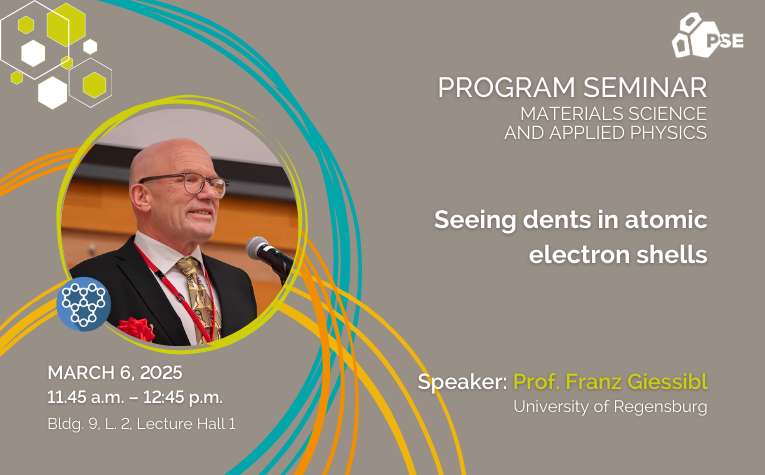Mar 2025

Abstract
This year, we celebrate 100 years of quantum mechanics. Explaining the atomic emission spectra of atoms was a giant early success of this non-classical theory. Directly “seeing” individual atoms remained elusive for a long time, though. When Binnig and Rohrer provided stunning images of the atoms of the silicon 7x7 reconstructed surface with the scanning tunneling microscope (STM) [1], it came as a surprise and many initially believed they were fake. STM relies on a quantum effect, electron tunneling, with its exponential increase at a factor of ten per Å (100 pm) between two biased conductive electrodes. The strong increase of current with distance reduction is key to the high spatial resolution of STM and its monotonicity facilitates distance feedback. In 1986, Binnig, Gerber and Quate introduced atomic force microscopy (AFM) [2], a method that also images samples by probing the atomic surface arrangement of a sample with, ideally, the single front atom of a sharp tip. Richard Feynman believed that the atomic hypothesis (“…attracting each other when they are a little distance apart, but repelling upon being squeezed into one another”) contains the most scientific information in the fewest words and started chapter 1 of his Feynman Lectures on Physics [3] with this statement. The AFM uses exactly these properties of atoms to create images – it senses a surface with a sharp tip mounted on a cantilever. The challenge is that this sensor needs to be able to probe forces small enough such that neither the tips front atom nor the sample are damaged on an atomic level. The silicon 7x7 surface was first resolved by AFM in a noncontact mode [4], where the frequency shift of an oscillating cantilever was used as a feedback mechanism [5]. Further progress was enabled by the invention of the qPlus sensor, a quartz cantilever that is self sensing and oscillates at sub-Angstrom amplitudes [6]. Outfitting its tip with a CO molecule allows to image organic molecules at unprecedented resolution [7]. To our knowledge, today AFM provides the greatest spatial resolution of all microscopes by resolving structures within single atoms [8,9]. The quantum corral, introduced by Crommie, Lutz and Eigler in 1993 [10], was revisited by AFM in 2021, showing that the 102 electrons that the corral contains can be viewed as the shell of a two-dimensional atom with similar bonding properties to AFM tips as a natural atom [11]. AFM is now also established as a powerful tool for the surface science of insulators [12].
References
Biography
Franz J. Giessibl obtained a prediploma in precision engineering at the University of Applied Sciences in Munich 1982 and continued to study physics from 1982 to 1987 at the TU Munich and at ETH Zürich. His PhD in physics was obtained with Nobel Laureate Gerd Binnig at the IBM Physics Group Munich at LMU Munich on atomic force microscopy (AFM).
He joined AFM manufacturer Park Scientific Instruments in Silicon Valley from mid 1992 until the end of 1994 and designed an AFM that established atomic resolution AFM as a tool to image all surfaces with atomic resolution, including the enigmatic Si 7x7 surface. After acting as Director of Vacuum Products at Park for a while, he became a Senior Associate in the Munich office of management consulting firm McKinsey from 1995 to 1996. At McKinsey, he conducted several benchmarking studies with clients in the high tech industry. The benchmarking studies triggered his invention of the qPlus sensor in his home laboratory in his spare time. In 1997, he obtained a permanent position at the University of Augsburg where he could show in 2000 that the qPlus sensor even enables subatomic spatial resolution.
In 2005, he was offered chairs at the University of Bristol and University of Regensburg, joining the latter in 2006. From 2005, he teamed up with the scanning tunneling microscopy (STM) groups of IBM in Almaden and Zurich and later with NIST in Gaithersburg as well as with several AFM manufacturers to help to spread the new opportunities that the qPlus sensor enables in imaging and force spectroscopy. His main invention, the qPlus sensor, is standard today for low temperature AFMs, it is used by six international AFM manufacturers and operates in more than 500 low temperature AFMs globally today.
Franz J. Giessibl is a Fellow of the American Physical Society and the Japanese Vacuum- and Surface Science Society. He has won 10 international science prizes, including the Feynman Prize on Nanoscience, and last year the Heinrich Rohrer Grand Medal and the NIMS Award.
Some of the images obtained by Giessibl and his team inspired the eminent visual artist Gerhard Richter to the offset print editions Erster Blick (2000) and Graphit (2004), leading to Two grey double mirrors for a pendulum, an art&science project in Münster, Germany.